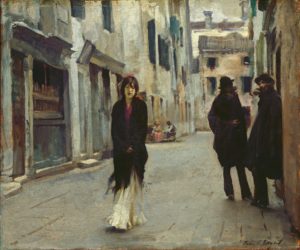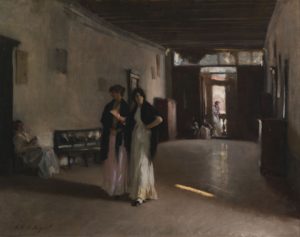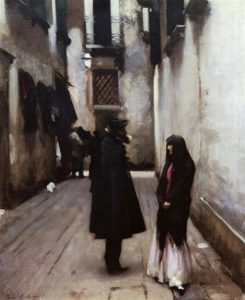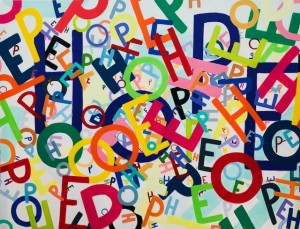Dear Artist,
We’ve talked a few times about audacity, which is a totally good thing unless you don’t know what you’re doing. Think of a surgeon giving someone an artificial hip with a load of audacity and no knowledge. It smarts, and besides, it causes you to walk funny. And then there’s the system of “commit and correct,” which is golden when you have something to commit to. Now here’s another: TTS — the “Timid Test System.” When you’re sitting back with a glass, looking at a work in progress, you’re asking, “What could be?” With time and a curious mind, a few ideas pop up. This is when you need to go up to the canvas and lightly touch in your possible maneuvers. Having put something in, however meekly, gives an idea of just how great something might be later. Toward the final stage of the painting, you can put it in with audacity.
The “What could be?” question is a personal one. What you ask is your own business and the follow up is in your own sweet time. It’s your ability to make choices that leads to effective, professional and unique work. It goes like this: “In that area, in that place, I wonder what it would look like……. if that light over there really dazzled? if there were an extreme gradation? if darks were really punched in? if that colour were rethought and sophisticated? if that colour were intensified or changed? if curves took precedent over straights? if this were made to line up with that? if there were a further element of depth added? if that place could be better formed?
A few years ago, just below the parking lot at Moraine Lake in the Canadian Rockies, I was painting and scratching my head. A couple in a Lincoln with Utah plates pulled up, and, after watching me from the car for a few minutes, got out and came closer. “Very much in the style of Robert Genn. Did you know him?” said the man. I told him I did a bit and that I thought Robert was probably still alive. I asked the couple if they thought my style might be a little more timid than Robert’s. “Yes,” he said, “yours is really nice, really good, but he had a lot of verve and energy in his, don’t you think?” I told them that like Robert I often put my verve and energy in later on. The couple watched me for a minute or so, then wandered down the beach. “Keep at it,” said the woman as they left.
Best regards,
Robert
PS: “Start with a whisk and end with a broom.” (John Singer Sargent)
Esoterica: Creativity means thinking on your feet, making adjustments and sorties as you go along, advancing commitment as well as erasure. Unless you express your wishes, however modestly or timidly, you may never know your power. Your general overall theme may be audacious, even simply audacious, but it is the final, well-planned flourishes that will help your work to fly.
This letter was originally published as “The Timid Test System” on October 12, 2010.
Have you considered a Premium Artist Listing? With each letter, an artist is featured at the bottom of this page. The Premium Artist Listings are a means of connecting artist subscribers through their work. Proceeds from each listing contribute to the production of The Painter’s Keys.
Featured Artist
Sometimes we see what no one looks for–images that have waited for us to find them. If we are lucky, these images will wait while we try to capture them with paint on canvas. They will probably change as we reach for them. I believe that if we clearly and honestly record what we see, we will be surprised, enriched, and sometimes stunned by what we’ve found.
There is almost always a narrative in my paintings as I believe that a story may be introduced in a scene. The viewer must fill in the before and after with unique eyes and experience, but enough can be presented to set a challenging stage if the work is successful.
Along with being a visual story teller, I’ve been called a colorist, surrealist, patternist, and sometimes a texturist. I’m an Atlanta artist–an oil painter for over twenty-five years–with a studio in Brookhaven. I love working with oils because each painting session results in a new revelation of what they might do. There is a mystical quality to each painting and each day for me.








11 Comments
I got such a chuckle from this post… thoroughly enjoyed it. Thanks for re-running it.
Oh what a great story about the couple coming up as Robert was painting. A lovely humble moment in the life of a painter. I can so relate to the process as he describes it. I currently have a painting blocked in and the surface ready to move past that head scratching place as I begin to build up the oil paint. I love this particular stage in painting where everything still seems possible. Happy painting everyone!
A great letter! One of your best.
What a wonderful anecdote! How humble of your father to keep his identity to himself, and not make a big deal of the man’s comment about the work not quite measuring up to Robert’s usual. It might have greatly embarrassed the man, who was obviously a fan of your dad’s work.
I love that Robert didn’t feel compelled to correct them and went with the flow of the conversation thus this great story and lesson in staying open to the viewers input and also not taking it too seriously! Thanks for the laugh this morning!
What a wonderful story from your father. Thank you, too, for the treasures from John Singer Sargent.
Timidness is an ever-present danger for me. It’s so easy to fall into the trap of “it’s always worked before.” After 40 years of painting, I need a lot of “what has always worked.” It’s gotten me where I am today. It’s dangerous when it becomes the crutch that keeps me from taking a big chance or trying something entirely new.
As a painter, if I’m to evolve and move forward, I need to heed Robert Genn’s advice, bid timidness goodbye and get on with it.
I remember reading this issue during my time teaching in Casablanca, Morocco. It’s probably about the time I started reading the posts regularly. I liked the story both times. The other view of the approach… I heard from Frank Gehry, architect, “ well, let’s just sit here and look at it and see what irritates us“.
Well, that was a great story to start the day, with a smile! Thank you so much. Only to b at a stage where strangers from another country see me painting and think my work reminds them of me
Thanks again,
Sharon
While I love the anecdote and Robert’s response, it really serves to point out that – if one practices timid starts and audacious endings – a painting in process will be fairly unimpressive. The real trick to this process will be to boldly end a watercolor without overworking it , and not to end an oil before it gets its last energetic zap. It’s that indescribable tension in the elements that speaks volumes. Maybe it’s also why just about any demo performed by even very talented artists are terribly disappointing. The real zing happens in the last 5 minutes off-camera and all by him/herself.
1984. I paint primarily in acrylic but fortunately I had a chance to take my first series of watercolor classes in Carmel, CA. We were on the 17 Mile Drive beach painting away when a tourist approached an artist three spaces right of me. She said to the artist, “How wonderful!” She also said “How wonderful!” to the next two artists She came to me and I was wondering if she was just going just repeat the same phrase. She looked at my work for a long time and then finally sighed and said, “Watercolor is hard, is it not?”
I was surprised, had a good laugh and now I enjoy passing on this story to my art friends!
another treasure! Thank you so much, as always, you make my days a whole lot better. xox
http://www.society6.com/julienorthey Paintings by Julie Northey on Facebook